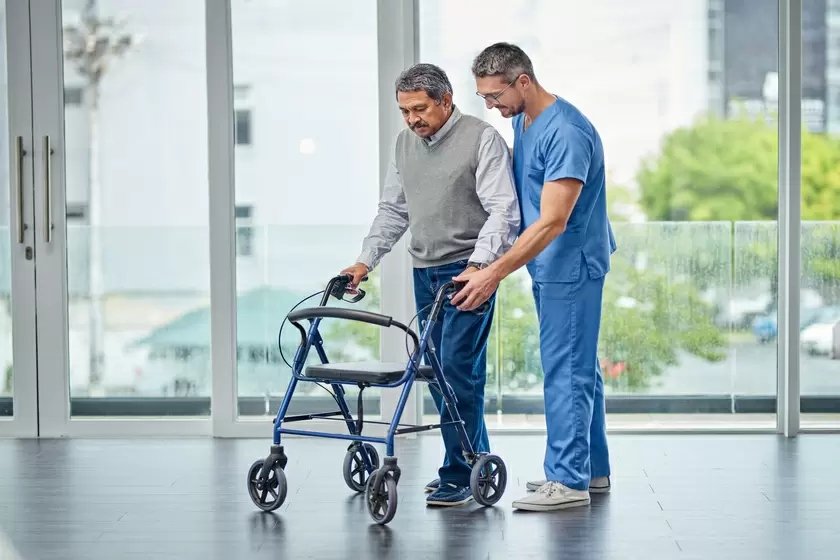As we age, our bodies change, and this can sometimes lead to difficulties with movement. Conditions like arthritis, muscle weakness, or balance issues can make walking and moving around more challenging. This is where walking aids, such as canes, walkers, and rollators, come in. These tools are not just accessories but vital aids that can greatly improve a senior’s mobility, safety, and overall quality of life. In this article, we’ll delve into the various ways walking aids help seniors regain independence and improve their mobility.
1. Enhanced Balance and Stability
Aging often leads to a decline in balance and coordination, which makes the risk of falling higher. Walking aids like canes and walkers provide crucial support that helps seniors maintain their balance. For example, a cane provides support on one side, while a walker gives stability on both sides of the body. Walkers have four legs or wheels that help distribute weight evenly, providing a strong base and reducing the chances of losing balance. This makes walking aids ideal for navigating uneven surfaces, such as sidewalks, stairs, and carpets.
Improved balance not only helps seniors walk more securely but also boosts their confidence. When seniors feel more stable and less worried about falling, they are more likely to engage in daily activities and continue with their routines.
2. Promoting Independence
One of the most significant benefits of walking aids is that they allow seniors to maintain their independence. As we age, it’s natural to need assistance from others, but too much reliance on others can be frustrating for those who want to remain self-sufficient. Walking aids provide the necessary support, allowing seniors to move about freely without the need for constant help from family members or caregivers.
Whether it’s walking to the kitchen, going out for a walk, or running errands, walking aids give seniors the confidence to perform these tasks on their own. This sense of independence can have a positive impact on their mental well-being and overall quality of life.
3. Preventing Falls
Falls are one of the leading causes of injury and hospitalization among older adults. The risk of falling increases with age due to weakened muscles, joint pain, or balance issues. Walking aids are designed to prevent falls by providing a stable point of contact with the ground. Whether using a cane or walker, seniors have more control over their movements, which reduces the chances of tripping or stumbling.
A walker, in particular, is an excellent option for seniors who have difficulty walking or who experience frequent falls. The four-legged structure of a walker provides more contact with the ground, ensuring stability and minimizing the likelihood of losing balance while moving. For seniors recovering from surgery or dealing with medical conditions, walking aids act as a support system to prevent further injury.
4. Improved Posture and Comfort
Using a walking aid can also help improve posture. Seniors who struggle with posture issues, such as slouching or leaning forward, may find that a walker encourages a more upright position. This is particularly helpful for seniors with back or joint pain, as proper posture can reduce strain on the spine and joints while walking.
Furthermore, using a walking aid can make walking more comfortable by reducing the physical effort required. A walker, for example, takes some of the weight off the lower body, easing the strain on the legs and hips. This can make it easier for seniors to walk longer distances or engage in physical activities without feeling fatigued or in pain.
5. Support for Daily Activities
For seniors dealing with conditions like arthritis or recovering from surgery, walking aids can be instrumental in daily life. They provide essential support for getting in and out of chairs, standing up from a seated position, or walking to different rooms. Some walkers even come with built-in seats, offering a place to rest when needed. This additional feature is especially beneficial for seniors who tire easily and need to take breaks throughout the day.
Additionally, walking aids make it easier to navigate spaces in the home or outside. Whether going grocery shopping, attending social events, or enjoying outdoor activities, walking aids provide a convenient and safe way to get around.
Conclusion
Walking aids are indispensable tools for seniors who want to maintain mobility and independence. They offer improved balance, reduce the risk of falls, and provide essential support for daily activities. Whether it’s a cane for light support or a walker for more stability, walking aids can significantly enhance a senior’s quality of life by making movement easier, safer, and more comfortable. With the right walking aid by Gilani Mobility, seniors can continue to live active and fulfilling lives, despite the challenges that come with aging.








